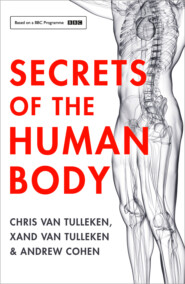По всем вопросам обращайтесь на: info@litportal.ru
(©) 2003-2024.
✖
Wonders of Life
Автор
Год написания книги
2019
Настройки чтения
Размер шрифта
Высота строк
Поля
Water arguably exhibits the most complex behaviour of any known substance. This may come as a shock, because the ubiquitous familiarity of its chemical signature – H
O – is the stuff of the most basic of classroom chemistry lessons. Yet this familiarity hides a deep complexity that we are only now beginning to understand. The complexity doesn’t lie in the structure of water molecules themselves of course: each molecule is made of three atoms – two hydrogen atoms and one oxygen atom. From chemistry lessons gone by, you might recall that the two hydrogen atoms are covalently bonded to a single atom of oxygen. Oxygen has eight electrons around its nucleus, six of which are in the outer shell; these are known as ‘valence electrons’. Four of these are paired together, leaving two lone electrons that would dearly like to pair up with electrons from other atoms.
Each hydrogen atom has a single electron, which it readily shares with the electron-hungry oxygen, and the result is a molecule of water.
However, this simple tetrahedral arrangement of a central oxygen atom surrounded by two pairs of electrons and two hydrogen atoms is deceptive, because the structure allows for tremendously complex behaviour when water molecules come together in large numbers. And, as we shall see, this unique behaviour may well make water a prerequisite for the existence of life, not only on Earth, but anywhere in the Universe. Perhaps unsurprisingly, given its dominance in our lives, scientists have been attempting to unlock its secrets for over three hundred years.
For those who don’t like such anthropomorphic language, it is energetically favourable for electrons with opposite spins to pair up in the available energy levels around a nucleus, and there are four available upper energy levels around the oxygen nucleus for the six electrons to occupy.
MOLECULAR GEOMETRY: Tetrahedral electron pair geometry
We often take water for granted, yet it is a remarkably complex substance, and without it there would be no life, not only on Earth, but anywhere in the Universe.
THE HISTORY OF THE EXPLORATION OF WATER (#ulink_a19d6856-e617-5050-a864-aa6ee387a28e)
In the eighteenth century, Europe was full of inquisitive men attempting to unlock the secrets of the natural world, and Henry Cavendish was certainly one of the most eccentric. It is said that he was unable to bring himself to interact with women outside of his family at all, communicating with his female servants by written notes and sneaking around his own house using a specially constructed staircase so as to avoid his housekeeper. His isolation was so extreme that he often kept his experimental findings secret, not publishing or sharing his research with anyone. Such was the extent of this secretiveness that it was only many years after his death that the true breadth of his discoveries became apparent.
Cavendish was a follower of phlogiston theory – a widely held belief that had its roots in alchemy. The theory suggested the existence of an element thought to be contained within all combustible material, called ‘phlogiston’. By the middle of the eighteenth century the theory had been widely discredited, yet Cavendish continued to see worth in it, and attempted to incorporate it into many of his observations. To modern ears, this makes his terminology sound rather eccentric, but his contribution to our understanding of the natural world was extraordinary, not least in his early work on the chemical properties of water.
In a series of experiments, Cavendish produced and isolated a gas by reacting hydrochloric acid with metals such as zinc, iron and tin. In doing so, he became the first person to identify hydrogen in the laboratory. He referred to this new gas as ‘flammable air’ in his poetically named paper ‘Factitious Airs’, published in 1766. Cavendish went on to show that hydrogen reacted with another gas, which he termed ‘dephlogisticated air’, to produce water. This gas was oxygen. His experiments with flammable air eventually led him to the first determination of the composition of Earth’s atmosphere – one part dephlogisticated air (oxygen) and four parts ‘phlogisticated air’ (nitrogen). There is something quite instructive in Cavendish’s approach to science. Even though his devotion to the phlogiston theory was wayward, to say the least, he did not allow his theoretical prejudice to contaminate his experimental results. This is why he was able to make genuine discoveries while holding at least some views about his subject that were flat-out wrong. That is the mark of a great experimental scientist!
ELECTROLYSIS OF WATER
We owe the modern names for the elemental building blocks of water – hydrogen and oxygen – to Antoine Lavoisier, one of the greatest of the pioneering eighteenth-century chemists. Great though he undoubtedly was, however, he made a fundamental error in naming these two elements that persists to this day.
He named hydrogen, entirely appropriately, from the Greek ‘hydro’ (meaning water) and ‘genes’ (meaning creator). Oxygen, however, with its Greek root of ‘oxys’ (meaning acid), incorrectly suggests that oxygen is a component of all acids. It would have been more accurate to call hydrogen ‘oxygen’, in that the majority of common acid-base chemical reactions involve the transfer of protons, which are the nuclei of hydrogen. But Lavoisier’s names have stayed with us, so oxygen will forever be ‘the acid giver’, which it isn’t.
By 1804, the final elemental description of water was given in a paper by the French chemist Joseph Louis Gay-Lussac and the German naturalist Alexander von Humboldt. Together, they demonstrated that water consisted of two volumes of hydrogen to one of oxygen, and thus gave the world the most widely known of all chemical formulae: H
O. If Lavoisier had got it right, we’d call water O
H rather than H
O. Such is history.
MR BELL’S GUIDE TO THE ELECTROLYSIS OF WATER
Everybody has a teacher whose very essence, usually distilled from endearing eccentricity, remains forever imprinted on their consciousness. I had such a teacher, and his name was Sam Bell. He used to gaze out of the thin windows over the playing fields on a darkening Oldham afternoon and growl strangely in a thick Yorkshire accent about how he could still see the old games master, Pinky Green, ringing a bell, before launching a board duster across the varnished benches towards a boy’s head. He’d undoubtedly face disciplinary proceedings for that today, but it made chemistry enjoyable to an 11 year old. Mr Bell’s trademark technique was to drill chemical reactions into your brain with an indelible power usually reserved for poetry. ‘The ploughman homeward plods his weary way, and HYYDR’GEN burns with a squeaky POP!’ This works, as I discovered when, half a lifetime later, I settled down with a car battery in front of a waterfall in central Mexico to explain the electrolysis of water to a television camera.
‘Electrons enter the water at the cathode, where a reduction reaction takes place, releasing hydrogen gas which burns with a squeaky pop in air. Oxidation occurs at the anode, producing oxygen, which rekindles a glowing splint.’ Perfect.
Cathode (reduction): 2 H
O + 2e
→ H
+ 2 OH
Anode (oxidation): 4 OH
→ O
+ 2 H
O + 4e
The point of all this, which will be important when we come to discuss photosynthesis later on, is to demonstrate that it takes a large amount of energy to split water into hydrogen and oxygen. This is because oxygen really wants to acquire the two extra electrons necessary to fill its outer shell, and hydrogen is a relatively easy place to get them. This in turn means that water is a very stable molecule, and it therefore takes a lot of effort – in this case the power of a car battery – to split it apart. But, really, the point is to show that I thought my chemistry teacher was brilliant.
ELECTROLYSIS OF WATER
WATER, WATER EVERYWHERE… (#ulink_56796c1c-1d3b-5bae-bead-77e0d538ce80)
Earth, the small blue planet, is unique within the Solar System in having liquid water on its surface today. Indeed, from space Earth is a water world, with 71 per cent of its surface covered by the liquid. This uniqueness is the result of Earth’s size and position in the Solar System, and not the scarcity of the life-giving molecule itself. Despite the fact that we have yet to discover another water world like our own, we know that, across the vast expanses of space, the seas, lakes and rivers of planet Earth are just a drop in the cosmic ocean – our Universe is literally awash with water molecules, and everywhere we look in space we can see that the Universe is wet.
This shouldn’t be surprising when you consider that hydrogen and oxygen are two of the most abundant atoms in the Universe. Hydrogen forms 74 per cent of all the elemental mass. The second-lightest element, helium, comprises 24 per cent. These two elements dominate because they were formed in the first few minutes after the Big Bang. Oxygen is the third most abundant element in the cosmos, at around 1 per cent by mass. Most of the rest is carbon; all the other elements are present in much smaller quantities. All of the oxygen and carbon atoms in the Universe today, including all of those in your body, were produced in the cores of stars by nuclear fusion and scattered out into space as the stars died. Apart from helium, which is satisfied with its full inner shell of two electrons, these atoms have an affinity for each other because of their desire to pair up their solitary electrons. As a result, they tend to form molecules. After the hydrogen molecule (H
) and carbon monoxide (CO), water is the third most common molecule in the Universe.
All of the oxygen and carbon atoms in the Universe today… were produced in the cores of stars by nuclear fusion and scattered out into space as the stars died.
Much of this interstellar ocean is created during the formation of stars. There are over 400 billion stars in our Milky Way galaxy alone, and each time a new star is born a chain of events leads to the production of water. Stars are formed when an interstellar cloud of gas collapses under the force of gravity. As the gasses fall inwards, they heat up until nuclear fusion is initiated. This process of collapse, followed by ignition, creates a powerful outward burst of gas and dust. When this material hits the surrounding molecular cloud, already rich in oxygen from previous stellar deaths, the plentiful hydrogen and oxygen can combine, producing water.
Water on Mars? This composite image, taken by NASA’s Mars Reconnaissance Orbiter, shows the polar ice cap of the ‘red planet’. The ice cap is believed to be made of ice and dust deposits.
On 22 July 2011, a team of astronomers from NASA’s Jet Propulsion Laboratory and the California Institute of Technology (Caltech) announced the discovery of the largest, most distant reservoir of water ever detected. A gigantic cloud of H
O, containing 140 trillion times more water than all of Earth’s oceans combined, was sighted over 12 billion light years away from Earth. It surrounds one of the most evocative and powerful objects in the Universe: a quasar with the catchy name APM 08279+5255. This active galaxy harbours a black hole 20 million times more massive than the Sun. The star systems and gas spiralling into this voracious monster release a power output equivalent to 1,000 trillion suns as they slide down the sheer space-time slopes. This generates a shock wave on a galactic scale, forcing hydrogen and oxygen molecules together in unimaginable numbers to produce a giant reservoir of water. The scale of the find is extraordinary, but so is its age. Since the light from the quasar took over 12 billion years to reach Earth, we are seeing the Universe as it was less than 2 billion years after the Big Bang. This reservoir is therefore very ancient indeed, and the discovery proves that life-giving water is not only abundant, but has been present in the Universe for a large fraction of its lifetime.
Water was there from close to the beginning of time, and the Universe is full of it. Our galaxy, the Milky Way, is also full of it, although it’s relatively dry compared to APM 08279+5255, with only around 350 billion times more water than Earth. This interstellar reservoir was part of the cloud that, 4.5 billion years ago, condensed into our Solar System and formed the oceans and rivers that cover our blue planet today.
Pond skaters can walk on water. However, it is not just their anatomical adaptations, but also the physical properties of water, that enable them to occupy this unique environmental niche.
WALKING ON WATER (#ulink_db22e9c0-0518-59bc-afc7-311ced47a524)
Of all the creatures on Earth, few exploit the unique characteristics of water as overtly as the family of insects known as Gerridae. You may also know them as pond skaters, water striders or Jesus bugs.
Gerridae are successful and vicious killers, piercing the body of a captured spider or fly with a specially adapted mouthpart and finishing it off by sucking out its insides. The 1,700 known species around the world are found in a large range of water habitats, from the pond in your back garden to slow-flowing rivers in the deepest recesses of the Mexican jungle. But it is not their killing methodology or diversity that makes these animals so interesting to school children and a physicist dabbling in biology; it is their ability to walk on water, like Jesus. Next time you look at a common pond skater, you’ll be observing a creature that exhibits an exquisitely balanced relationship between its anatomical features and the physical properties of water, because the Gerridae is beautifully adapted to life at the interface between water and air. Its short front legs are used for capturing prey, while its middle legs propel it through the water. Its back legs are long and slender, spreading the animal’s weight over a larger surface area. These gangly appendages contribute to the pond skater’s ability to walk on water, but alone they would not be enough to keep it afloat. Every square millimetre of its body is covered with a cohort of tiny hairs that increase the surface area still further. These hairs are also hydrophobic, making the whole animal water-resistant. Without this adaptation, a single drop of rain would be enough to weigh the creature down and sink it below the surface. Even if the animal is pushed under, the tiny water-repelling hairs trap air, adding buoyancy and returning the creature to the surface. All of these anatomical features combine to allow the pond skater to live out its life in this unique environmental niche, moving around the water’s surface at speeds of up to 1 m per second – remarkably fast for such a small creature. Yet all these clever adaptations alone would not keep a pond skater afloat if it wasn’t for the especially strong bonds that exist between the water molecules themselves, and it is ultimately these bonds that make water so vital for life. This is why we chose this common but fascinating little animal as our introduction to the wonder of water.
This image of pond skaters was taken from underneath the water, looking upwards. The strong bonds between the water molecules help to prevent the insects from breaking the surface.
The pond skater’s back pair of legs spreads the animal’s weight over a wider area, while the middle pair propels it through the water.
Look at a common pond skater, and you’ll be observing … an exquisitely balanced relationship between its anatomical features and the physical properties of water.
TREETOPS TO TEARDROPS: THE MAGIC OF HYDROGEN BONDS (#ulink_0083dadd-dad4-5278-add5-68794f797241)
Water is colourless, tasteless, odourless and has a simple chemical formula – H










